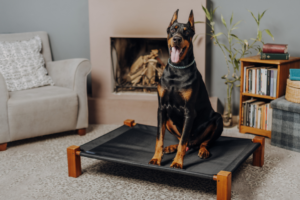Helping Your Dog Move Safely and Comfortably
Dog stairs, also known as pet steps, can be an incredibly useful tool for pet owners looking to provide their dogs with safe and comfortable access to higher areas. Whether your dog needs assistance getting onto the couch, into the car, or up onto the bed, dog stairs offer a simple and effective solution. In this article, we’ll explore the many benefits of dog stairs, why they are especially helpful for certain breeds and ages, and tips on choosing the right set for your furry friend.
Why Consider Dog Stairs?
As dogs age, they may experience joint stiffness, arthritis, or general difficulty with mobility. Additionally, some smaller breeds simply struggle with reaching elevated surfaces. Dog stairs are designed to reduce the physical strain involved in jumping or climbing, making it easier for dogs to access the places they love while minimizing the risk of injury.
Dog stairs come in various designs, materials, and sizes, making it easy to find an option suited to your home decor and your dog’s specific needs.
Benefits of Dog Stairs
Using dog stairs offers numerous advantages for dogs and their owners, ranging from improved joint health to a greater sense of independence for the dog. Here are the key benefits:
1. Reduces Stress on Joints and Muscles
One of the main benefits of dog stairs is that they reduce the physical impact of jumping on and off elevated surfaces. When dogs jump up or down from high places, they put considerable strain on their joints, especially in the hips, knees, and elbows. Over time, this can lead to joint issues or worsen existing conditions, particularly in older dogs or breeds prone to hip dysplasia or arthritis.
By providing a gentle, graduated incline, dog stairs allow dogs to access heights without putting unnecessary stress on their joints and muscles, supporting long-term health.
2. Supports Dogs with Arthritis or Joint Issues
For dogs suffering from arthritis, joint pain, or other mobility issues, dog stairs can be life-changing. The gradual steps provide an easier, less painful way for these dogs to access higher areas, such as a couch or bed. By minimizing the need to jump, dog stairs can help alleviate discomfort and make daily activities more manageable for dogs with chronic joint issues.
Breeds that are more prone to joint issues, such as Labradors, German Shepherds, and Golden Retrievers, can benefit greatly from the added support that dog stairs provide.
3. Ideal for Small Breeds
Smaller breeds, such as Dachshunds, Chihuahuas, and Shih Tzus, may struggle to reach elevated surfaces due to their size. Dog stairs offer an accessible solution, allowing them to get onto furniture or into cars independently. Because small breeds are often delicate and susceptible to injuries from high jumps, dog stairs provide a safe and practical way to prevent accidental falls or overexertion.
4. Promotes Independence and Confidence
For dogs that enjoy being near their owners but struggle to reach beds, couches, or other high areas, dog stairs can provide a sense of independence. When they can access these places on their own, they are less reliant on their owners for assistance. This can be especially beneficial for dogs that may feel anxious or frustrated by being left out of certain spaces in the home.
Dogs that can move around freely tend to feel more confident and comfortable in their environment, which can positively impact their overall behavior and well-being.
5. Prevents Injury from Jumping
Frequent jumping on and off high surfaces increases the risk of injury, particularly in puppies, small breeds, or dogs with weak joints. Even young, healthy dogs are at risk of straining a muscle or suffering a fall when jumping repeatedly. Dog stairs help minimize these risks by providing a safe, easy route for dogs to climb up and down.
For puppies, whose bones and joints are still developing, dog stairs can prevent potential injuries that could lead to long-term joint issues.
6. Eases Access for Senior Dogs
Senior dogs often face mobility challenges, whether due to age-related arthritis, reduced muscle strength, or general wear and tear. Dog stairs provide an easy-to-climb solution that allows senior dogs to continue enjoying favorite places, like the couch or bed, without risking their health. Stairs can help senior dogs feel comfortable and capable, enhancing their quality of life even as they age.
Tips for Choosing the Right Dog Stairs
When selecting dog stairs, it’s important to consider factors like your dog’s size, weight, and specific needs, as well as where the stairs will be used. Here are some tips to help you find the perfect set of dog stairs:
1. Consider the Height and Width
Choose stairs that are tall enough to reach the intended surface, whether it’s a bed, couch, or car. Each step should be wide enough to accommodate your dog’s paws comfortably. Smaller dogs may need narrower steps, while larger breeds require wider steps for stability.
2. Material and Traction
Dog stairs are available in various materials, including foam, wood, and plastic. Look for steps with non-slip surfaces or built-in traction to prevent slipping. Foam steps are softer and often more comfortable for dogs with joint pain, while wooden or plastic steps are sturdy and durable.
3. Weight Capacity
Check the weight limit to ensure the stairs are sturdy enough for your dog’s size. Heavier dogs need stairs with a higher weight capacity, as lightweight stairs may not provide adequate support.
4. Portability and Storage
If you plan to use the stairs in multiple areas or take them on trips, consider lightweight, foldable options. Some stairs are designed to be portable, making them easy to move and store as needed.
5. Ease of Cleaning
Choose stairs with removable, machine-washable covers or easy-to-wipe surfaces for hassle-free cleaning. Keeping the stairs clean is especially important if your dog uses them frequently.
How to Introduce Your Dog to Dog Stairs
While some dogs may naturally take to stairs, others might need a bit of encouragement. Here are a few tips to help your dog get comfortable with their new stairs:
- Use Positive Reinforcement: Place treats on each step to encourage your dog to explore the stairs at their own pace. Reward them with praise and treats as they move up and down the steps.
- Take it Slow: Allow your dog to get used to the stairs gradually. If they seem hesitant, practice for a few minutes each day until they gain confidence.
- Make it Part of Their Routine: Encourage your dog to use the stairs regularly, especially if they lead to a favorite spot like the bed or couch. Consistency will help them see the stairs as a familiar and useful tool.
Woof. Woof.
Dog stairs offer a simple, effective way to improve your dog’s mobility, protect their joints, and reduce the risk of injury. Whether you have a small dog, a senior, or a breed prone to joint issues, dog stairs provide support and accessibility, allowing your pet to move around safely and comfortably. By choosing the right set of stairs and introducing them gradually, you can enhance your dog’s quality of life and keep them close by for years to come.





























